Triumph Speed Triple 1200 RR Review
Bike Test by Wayne Vickers – Images RBMotoLens
For a long time, I, like many others I’m sure, have been waiting for Triumph to build a ‘full size’ 675/765 Daytona. I mean the original Daytonas (think 595, 955 etc) were full size jobbies, then they teased us with the 675 – a pukka sports bike junior burger.
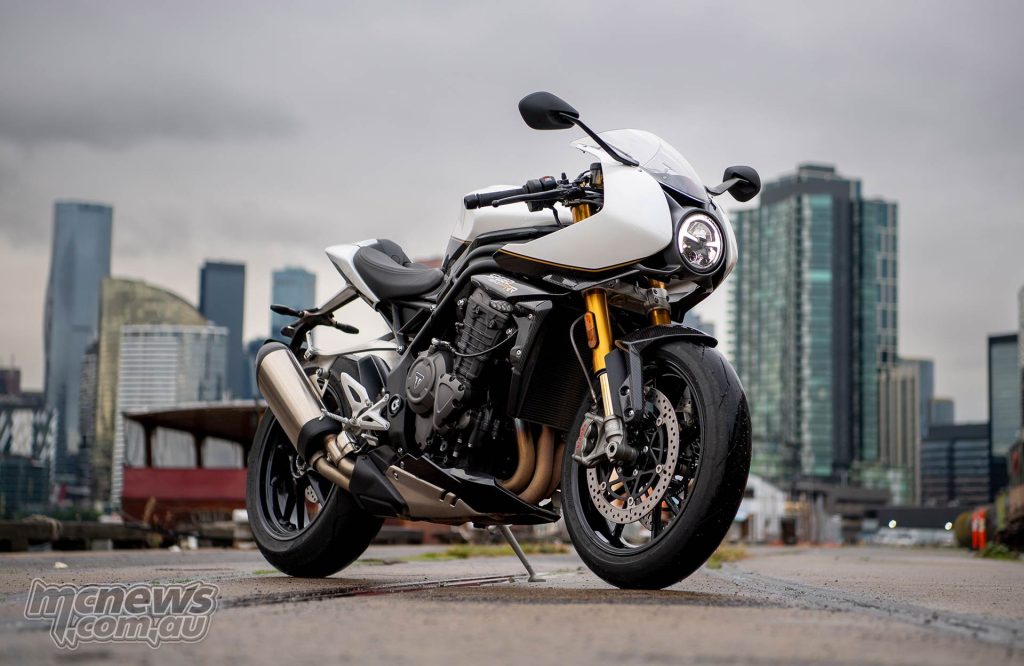
And what did we get? Bupkis. Well not quite nothing I guess. We did get the 765, but that’s like saying we still get a Honda Fireblade. Because they’re both low production, big spend, track toys really. Not something for the masses. Booo.
Then Triumph launched the new Speed Triple 1200 RS (full run down here) and it was mega. As a sports naked it ticks a lot of boxes. It’s comfy, lively and has gobs of style as well as plenty of performance. 180 ponies of gloriousness in fact. Is a very, very good Juan.
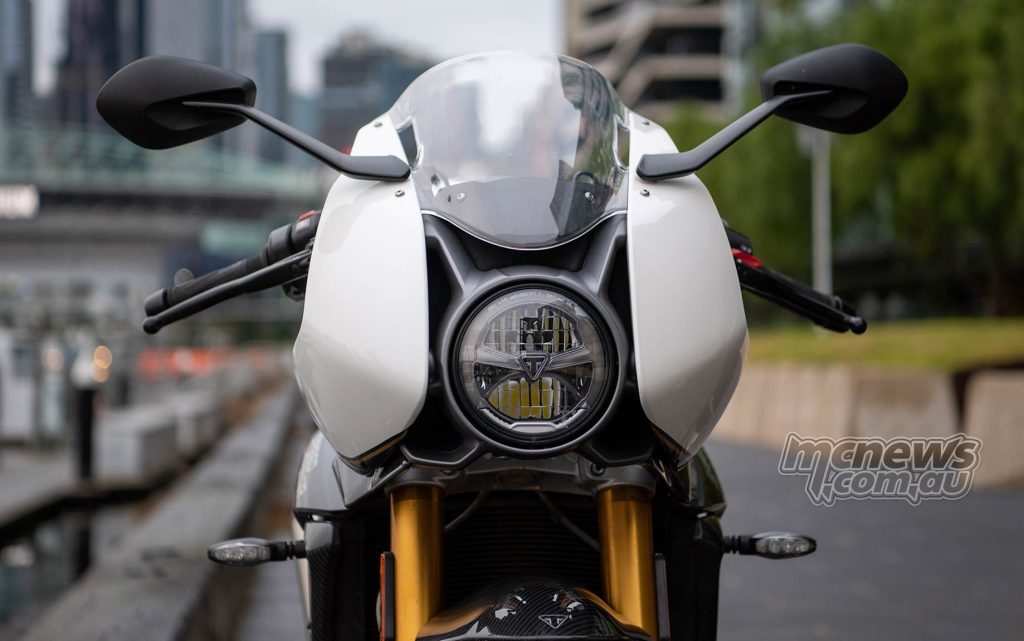
And now… they’ve lobbed the RR at us. And I will put my hand up and say my first reaction was something along the lines of, ‘Well it’s probably the nicest looking neo-retro-cafe-racery thing so far, but it’s just an RS with a front cowl option isn’t it? How different could it be?
I didn’t join the dots to the fact that it in a lot of ways – it’s the big 675 Daytona that we asked for, but in a stylish front cowl instead of a full body suit.
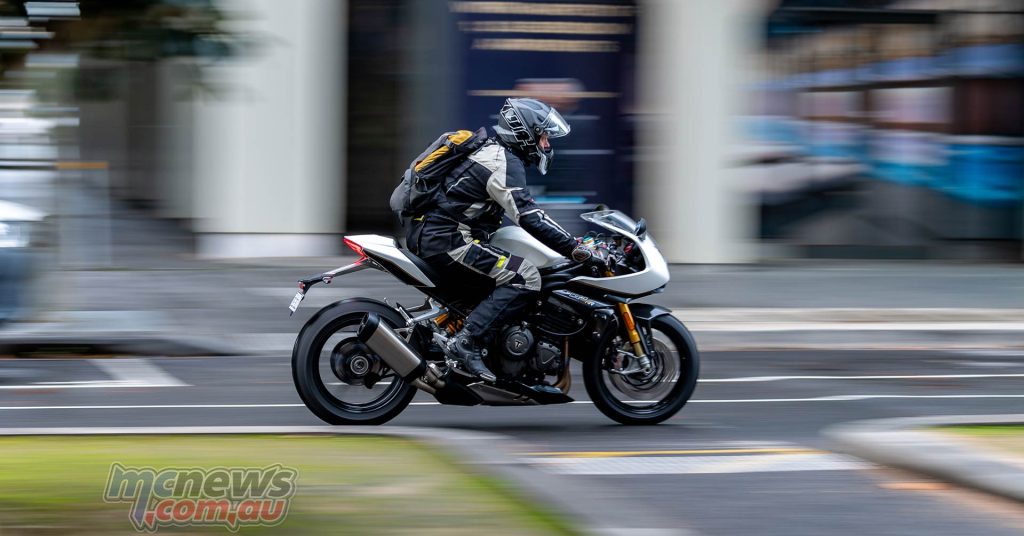
I think Triumph have been really, really clever here. Think about it for a sec. ‘Proper’ race-rep style sports bikes have been getting less and less practical on the road for a while now and have lost their mass appeal. We’ve been impatiently waiting for something different.
Something that’s sporty but not a pain to live with day to day. That goes hard yet doesn’t require a mobile chiropractor. Stands out in a stylish way and doesn’t scream racer boi. Is smoother than teflon coated butter around town yet happy to indulge a little enthusiasm (or a lot) should the mood take you. A modern day, road-oriented sports bike.
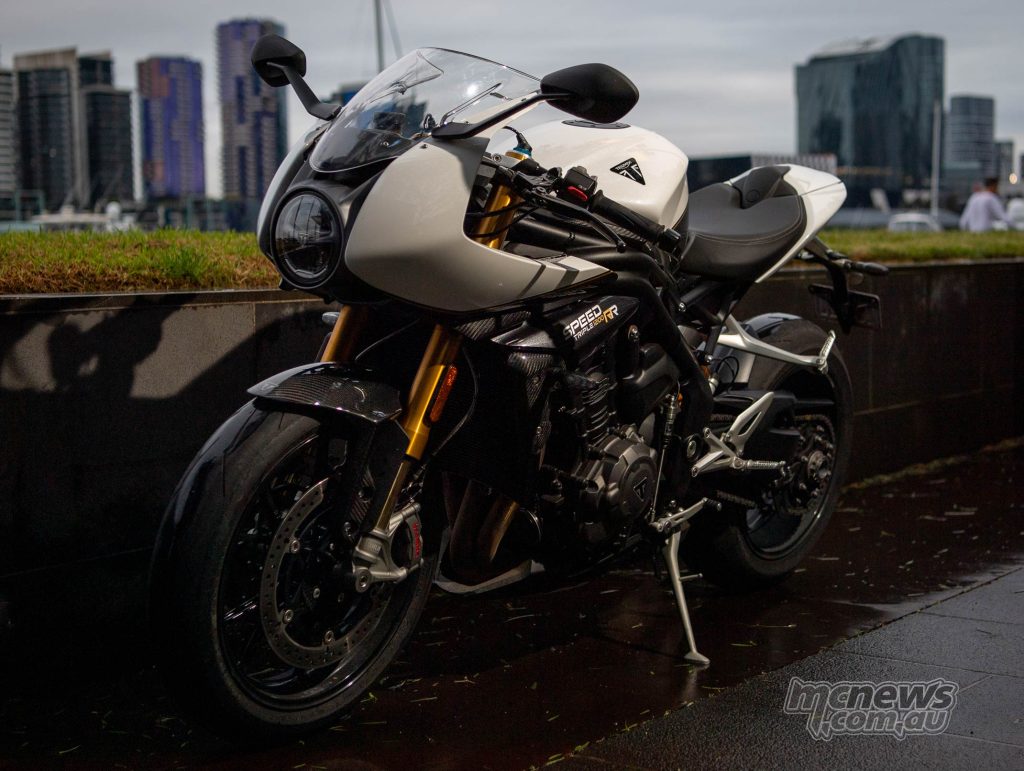
Ladies and gentleman, boys and girls, I give you the Speed Triple 1200 RR. I admit, I questioned it when I first threw the leg over and stretched my mits down to those clip ons. I thought it might have just skewed a little too far towards racey. And certainly – it was a bit of a shock to the system on the first of my 80 minute each way commutes.
Especially the solid 45 minute stretch of batshit boring straight highway. But I’ve now spent nearly three weeks on it, clocking up almost 2,000 kms. And I reckon they’ve got it mostly right. It might not be the big Daytona we originally asked for – but it’s the one we need (thanks for sticking it out with me till we got to the end of that analogy – you get a sticker*).
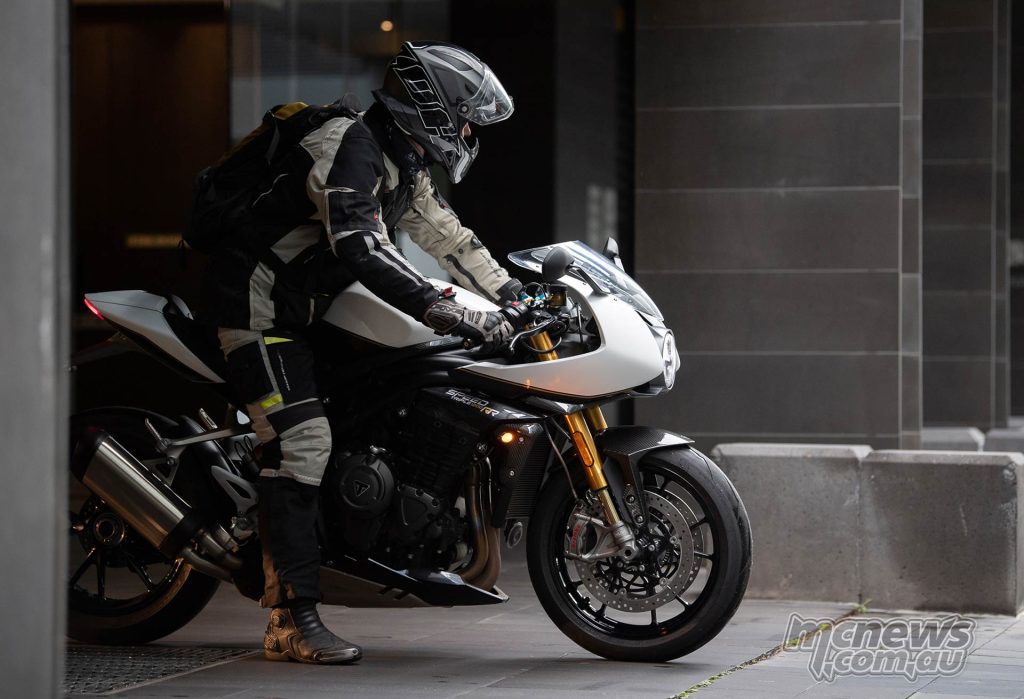
Now you might rightly say, “But Wayno you daft plonker, it’s just a sports naked with a screen and we’ve already got sports naked bikes.” And you’d be right. But this isn’t really a sports naked. And not because it’s got a tidy little screen on the front. Nor just because it has clip-ons. But because of the way it performs as a whole package and how its been designed to be RIDDEN like a sportsbike – on the road.
The cleverness becomes even more apparent when you realise how little Triumph had to change to make it possible. So before we go on – I suggest you stop putting it in the sports naked box. And just put it in the sports box. Now, with that out of the way – what are the real differences between this and the RS – and how does it go?
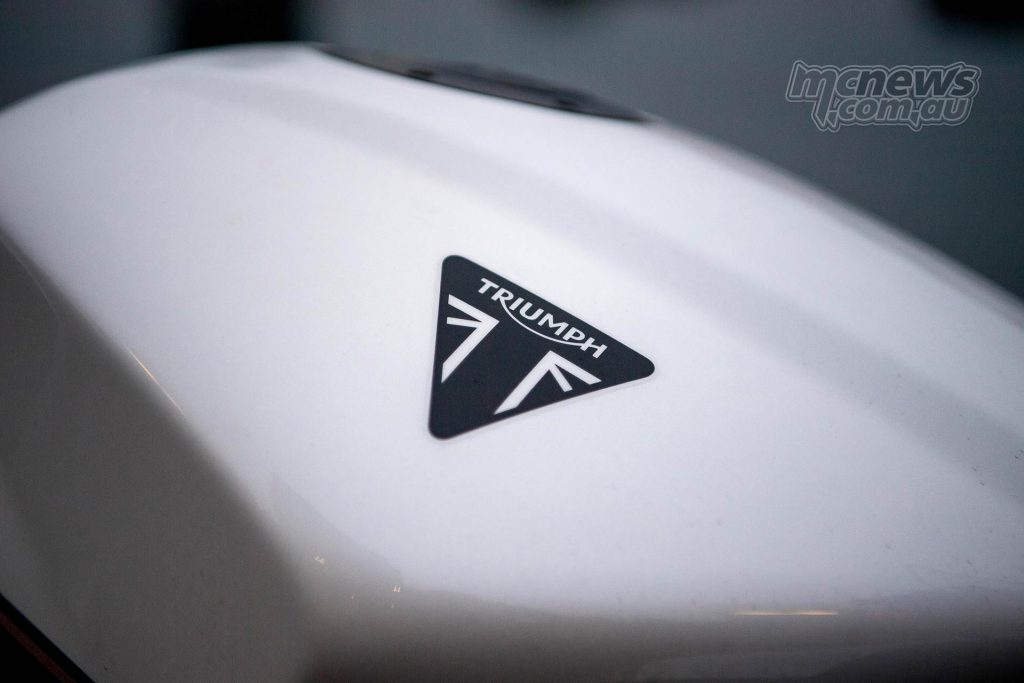
Well. Fundamentally, this is the Speed Triple RS which I reviewed not long back, with a stylish front screen and some very nice carbon touches, lower clip-ons, higher rear sets, some tasty electronic suspension and more aggressive rubber.
The Speed Triple 1200 RR still shares:
- That glorious 1200 (1160 cc) triple engine punching out 180 ponies.
- Those superb Stylema Brembos.
- The same six-speed box with one of the smoothest upshifts in the business.
- Single-sided swingarm and general elegant styling.
- A wet weight of 199 kg (which is only 1 kg more than the RS so close enough).
- A 15.5 litre tank that will see you to around 250 km.
- The usual gammit of electronic wizardry, ABS, TC, customisable ride modes.
- A refreshingly clean dash design.
- The same 16,000 km service intervals.
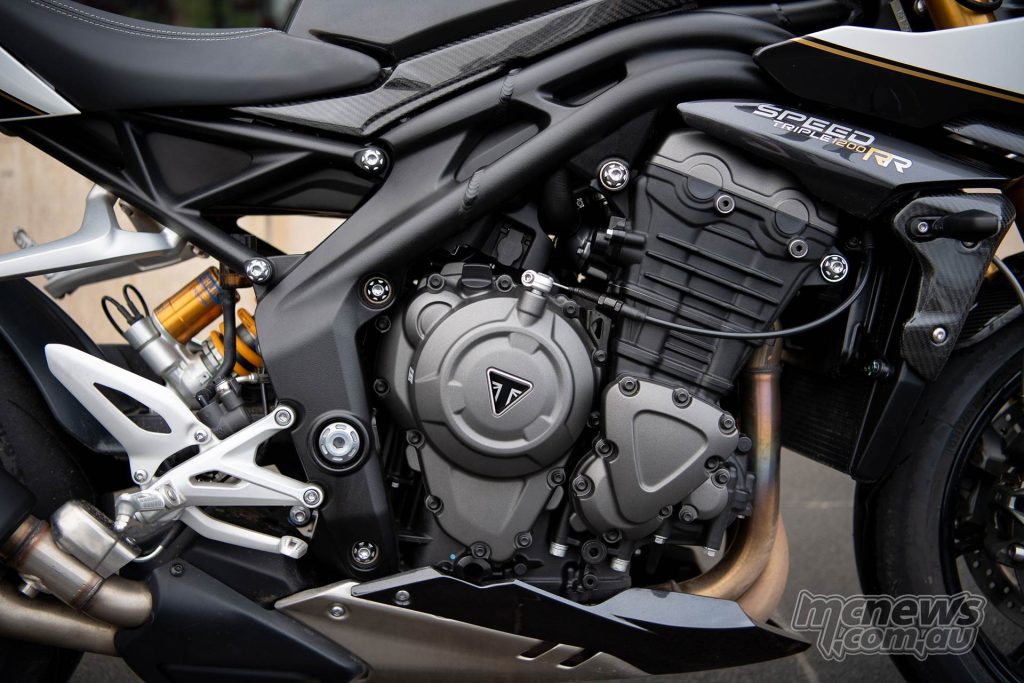
So mechanically the Speed Triple 1200 RR is just as good as the RS, which is to say… it’s really, bloody good. That engine is an absolute peach. I raved about it when I rode the Speed Triple 1200 RS so I won’t talk too much about it here, other than to say it’s right up there amongst my favourite donks.
Torquey, smooth, well behaved and adaptable. With the ability to politely trickle amongst traffic just above idle on your way to stretching its legs in third gear on your favourite set of corners. You’ll never be left disappointed.
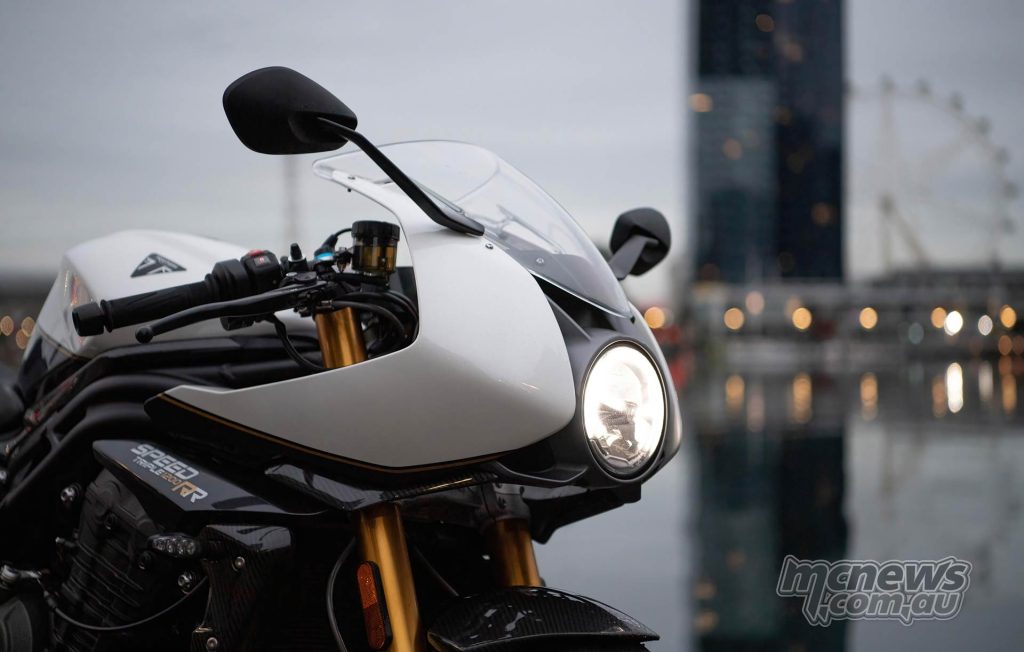
So let’s focus mostly on the ride position and suspension. The pegs are moved 15 mm higher and 35 mm back to help focus the riding position. That focus is further delivered by those clip-ons that position the grips 135 mm lower and 50 mm further forward than the Speed Triple RS’s bars. Which admittedly is quite a lot. If you’re comparing them back to back.
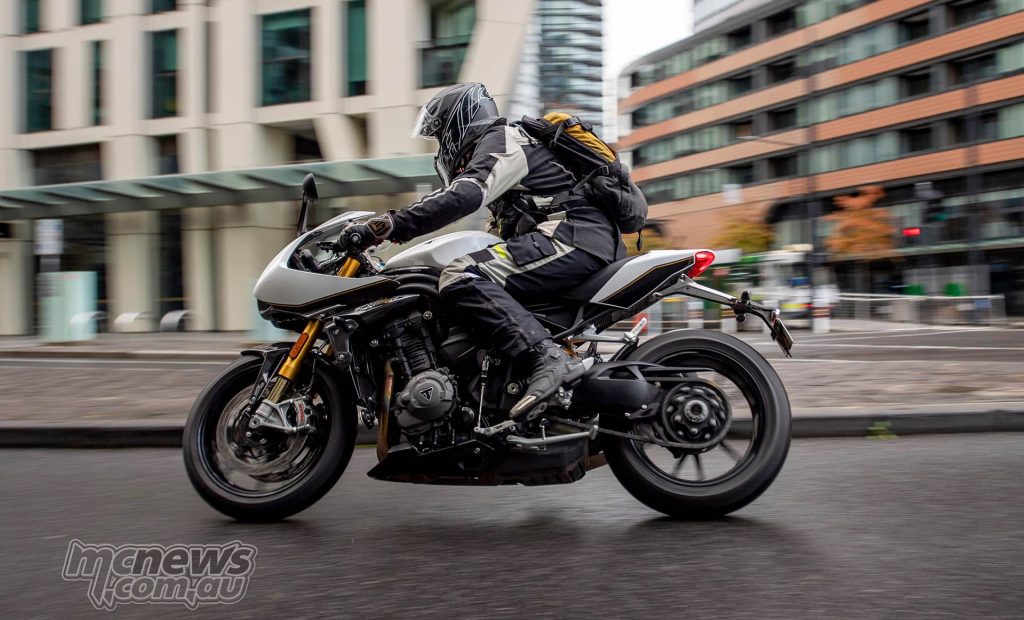
But in isolation – it’s sporty, without being a torture rack. Certainly more older generation Fireblade than current Panigale. By comparison, I’d just stepped off Suzuki’s GSX-S1000 GT to this and the riding position is noticeably more focussed on the Triumph (the GT has high bars after all), but still manageable.
If you aren’t used to that type of riding position for extended periods of time you’ll need to activate some of those forgotten core muscles and your legs might also do some more work. A little effort to support your weight with the legs and keep the wrists loose sees it all start to make sense. It’s definitely worth it.
While that front screen doesn’t offer a huge amount of protection from the elements, it does do a nice job of channelling the air onto your chest to take some further weight off your wrists. Nicely styled too I reckon. The whole thing looks like it was designed this way from the start.
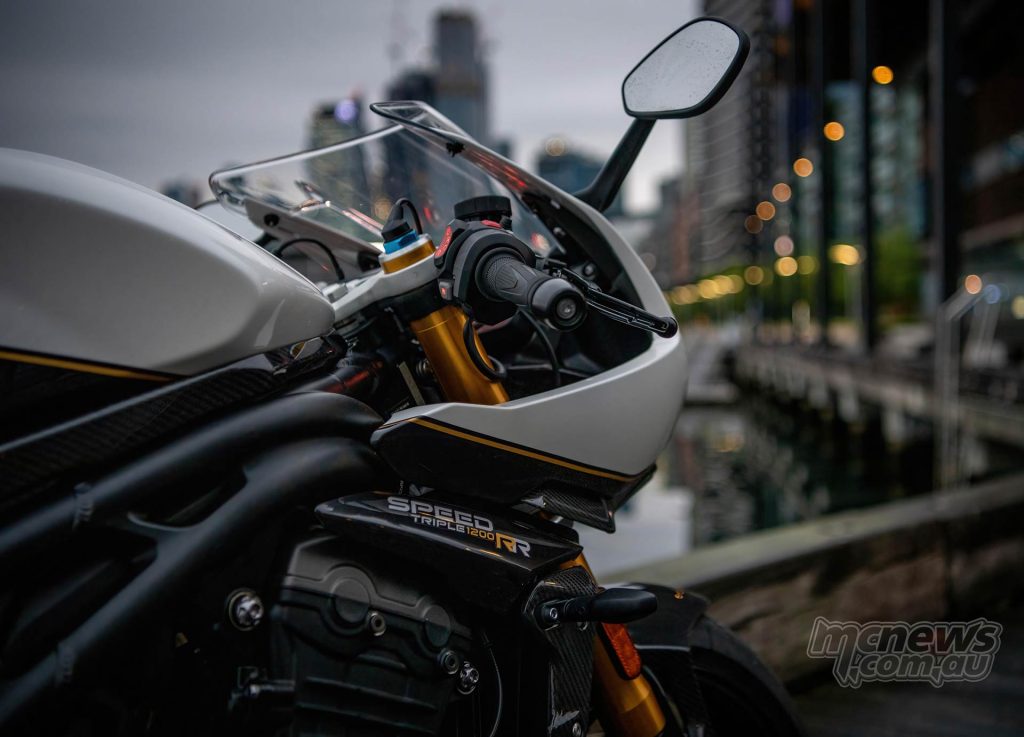
Makes me wonder how long it will be until someone does a single headlight conversion on the RS to be honest… Also worth noting that the change in riding position eliminates the minor issue I had with the lower edge of the tank to frame surface juncture being distracting on the RS.
Admittedly I’d do the old forearm on the tank thing every now and again while cruising on the highway – and I did find that making good use of the cruise control helped my not-really-26-anymore bones. But after a week – it felt normal. And very doable. Put another way. I would not be able to live with any other fully focussed sports bikes as my do-everything road bike and commuter. But I could happily have this.
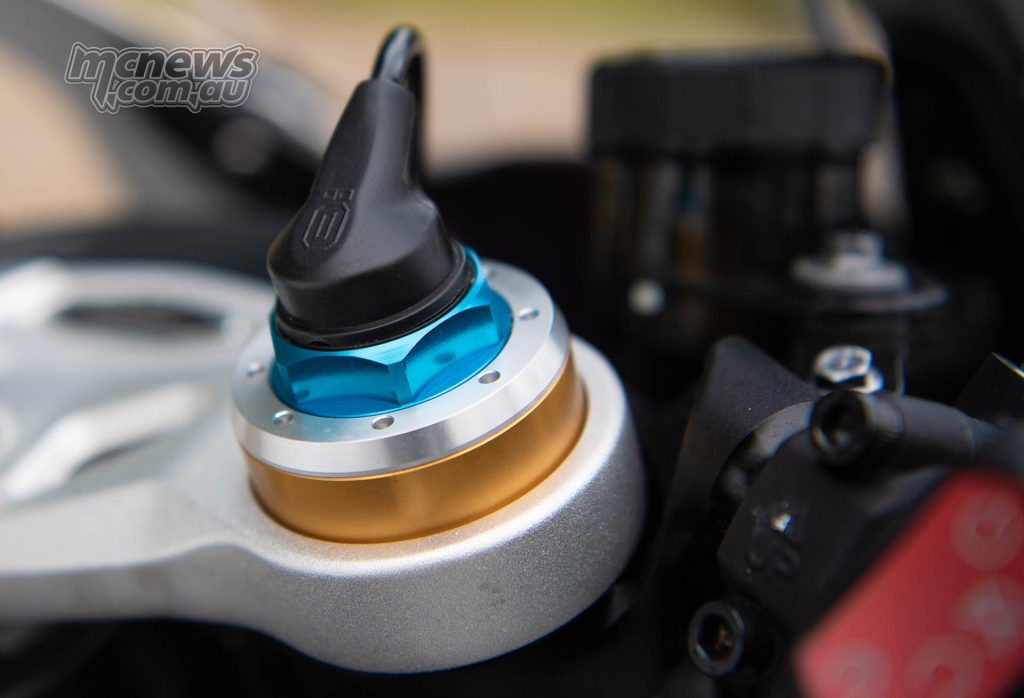
And with the delicious electronic Ohlins EC2 suspension adjusted well into the comfort setting, I found it perfectly doable as a commuter. Once upon a time I scoffed at electronic suspension. Not any more. This kit is epic. I did think that even in comfort setting it was probably still firmer than it needed to be, but quickly jumping into the settings and backing both front and back off another two steps seemed to be the all round Goldilocks for everyday riding. The damping control is amazing, soaking up decent hits while still being firm.
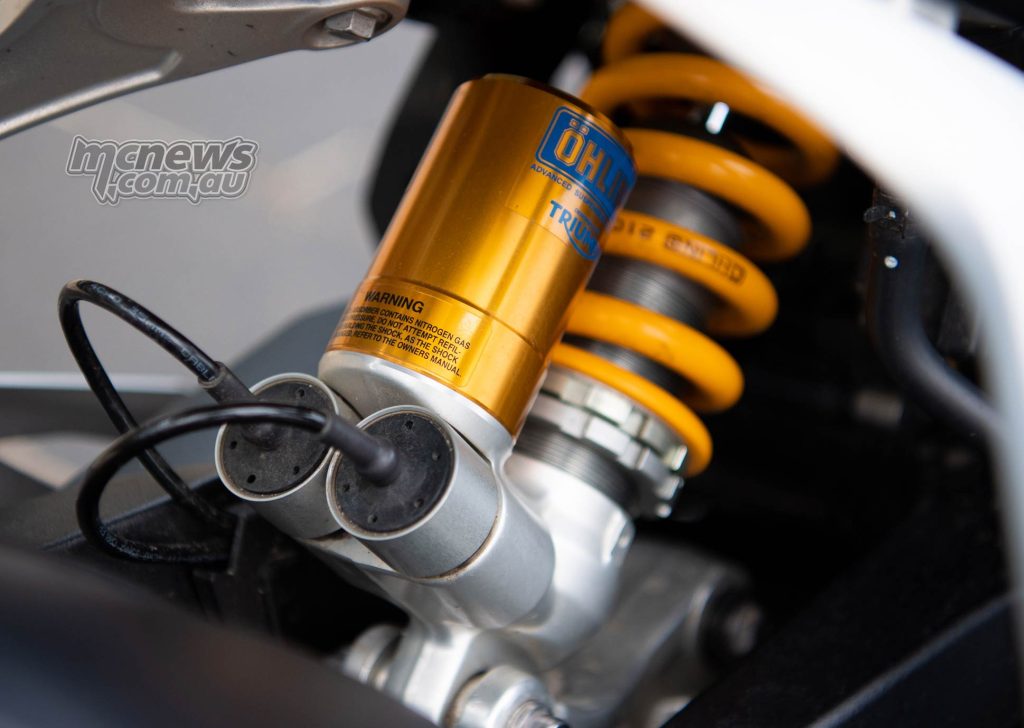
And that Goldilocks word seems to sum up my thoughts on the overall package. Not too soft, not too racey, just right. Sure, if you’re looking for just a track bike, it might not be for you. There are better options. If you just want something to travel huge distances two up, same goes. But as a road going sports bike that can do most things well enough? Gee, it’s pretty good.
The extra weight forward transforms the handling from ‘lively’ on the RS, to planted and assured on the RR. Add the amazing damping control into the mix and the overall impression is one of a really nicely dialled in, well balanced steed. It’s wonderfully smooth, predictable and instinctively usable. Change of direction is good, tip in is good, mid corner balance is good, grip on exit is good. It’s damn near faultless as a road sports bike.
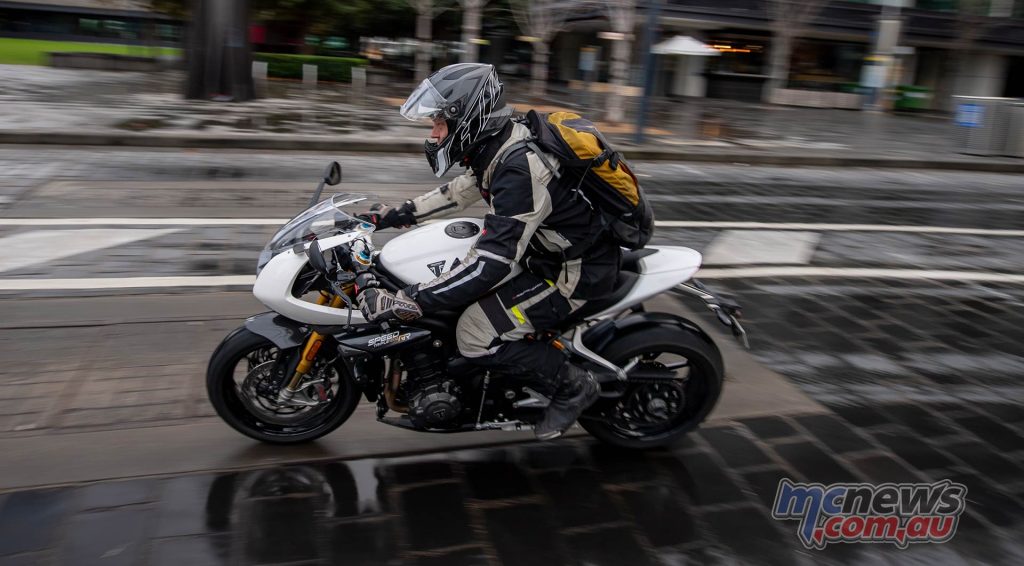
What would I change? Not much to be honest. It’s got the same squealy rear pad like the RS did, so maybe a simple material change there. I drag a bit of rear brake while filtering and low speed manoeuvring – and light applications get a squeal. More liberal applications have no noise issues so it might be something I could live with and it has a nice feel and plenty of power, as does the front. But I’d probably experiment with pads.
The gear lever feel is still not quite right either. The up-shift at all revs is terrific, in fact I challenge anyone to shift more smoothly at part throttle low revs than this quick-shifter can do. Silky short-shifts at just under four thousand revs are a delight.
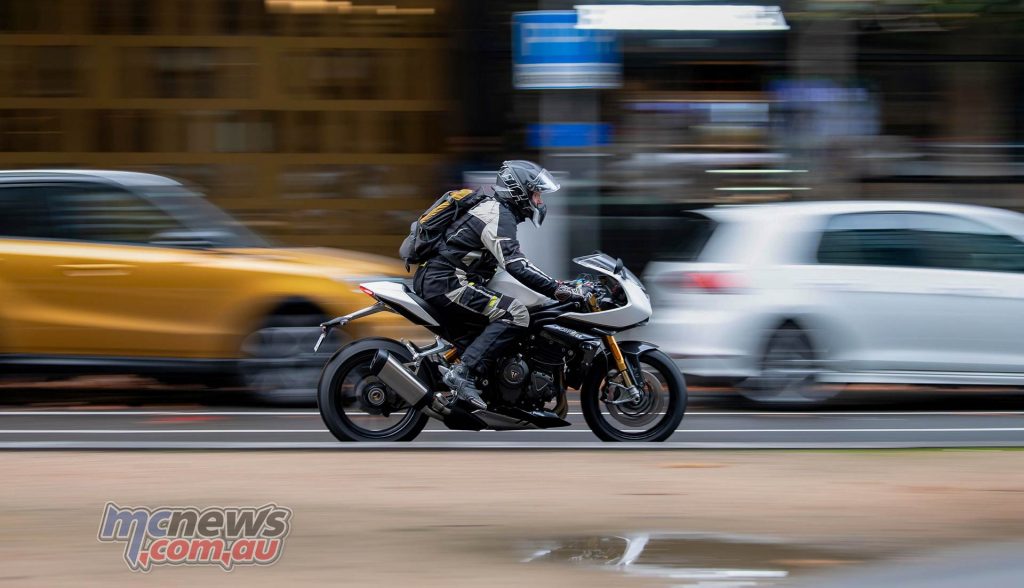
The down-shift is fine at higher revs but I found it a little lurchy at times in the lower revs so I ended up using the clutch around town and when cruising along (which was just fine). It’s more the lever feel under your foot that I still didn’t gel with (same issue on the RS) – although I’m getting far more used to it.
Especially noticeable on downshift, there’s some flex in the lever action that you can feel *after* the shift has already been made. It’s just a bit detached. Not a showstopper though. It falls squarely into the ‘you wouldn’t kick a supermodel out of bed for farting’ category.
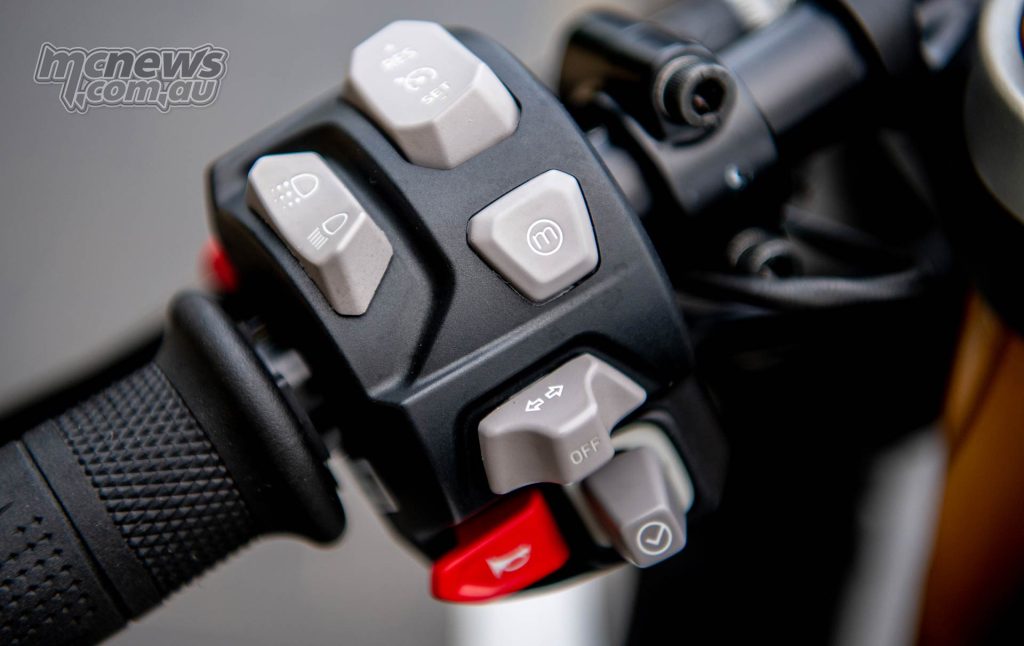
And finally, a bike this special should have come with a bit more music via a slip on. Which would also distinguish it a little more from the RS. Triples can sound A-mazing. Admittedly both the RR and RS sound good from the factory. But I know there’s more there just begging to be liberated.
So ultimately, if you haven’t figured it out by now, I like this bike. A lot. Triumph have taken their street fighter and turned it into a bit of a unicorn. I’m lucky enough to be in a position where I get to sample a fair range of bikes. Most are good, some need work, and a handful are something special for one reason or another.
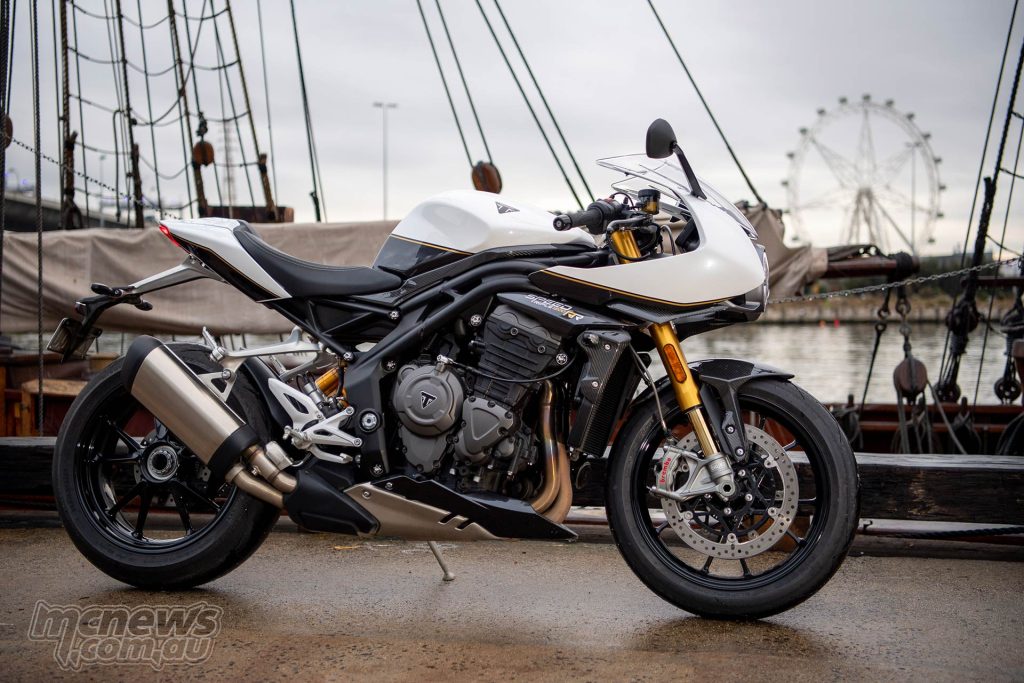
The Triumph Speed Triple RR is certainly in the latter group. The fact that it doesn’t really seem to have much in terms of direct competitors makes it even more extraordinary. I hope it sells its pants off, so more manufacturers will build bikes like it.
Bravo Triumph. You’ve reignited my interest in sports bikes and the idea that I could actually own one as my daily. For me personally this is probably the only sports bike I’d honestly consider owning as I need my road bike to perform multiple duties (including a daily 230 km commute) and most other offerings are just too focussed to work for me.
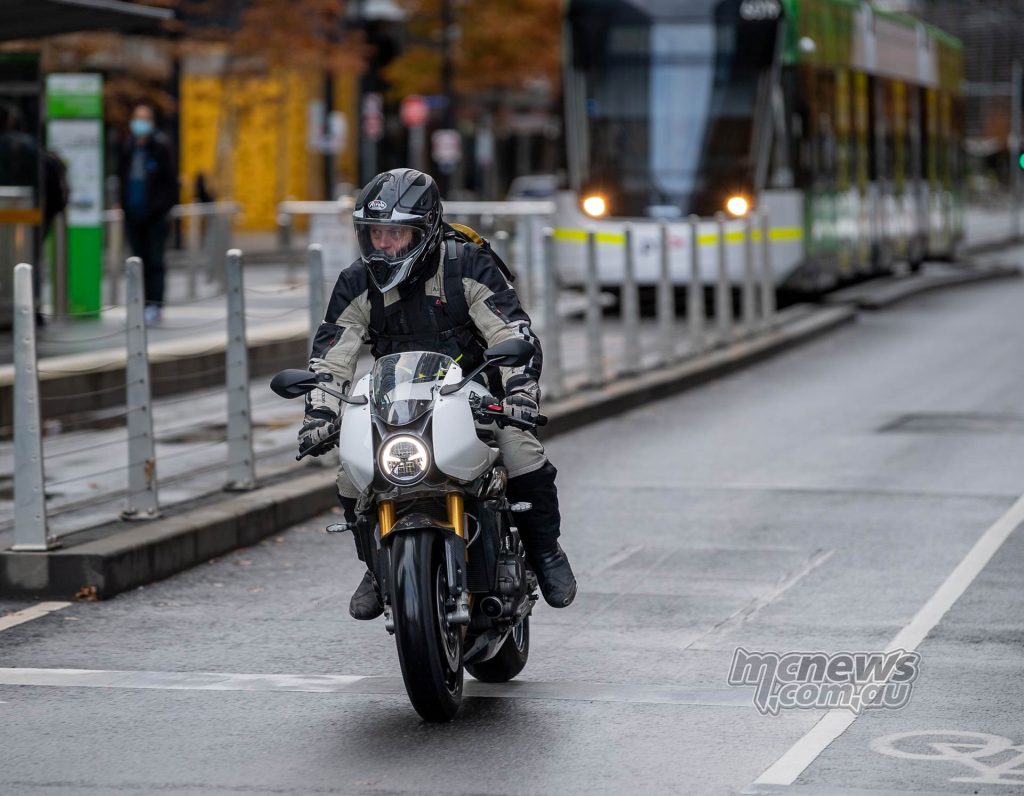
What a lovely thing.
Why I like the Triumph Speed Triple 1200 RR:
- Finally. A proper road-oriented sports bike.
- Exceptional 1200 cc driveline.
- Wonderfully elegant styling.
- It might not seem like much of a change from the RS, but it is. Superb.
I’d like the Triumph Speed Triple 1200 RR more if:
- Heated grips as standard please.
- A more liberal slip-on to release the music.
- Can we reduce some of the flex feeling in the gear lever on downshift?
2022 Triumph Speed Triple RR Specifications
| Engine & Transmission | |
| Engine | 1160 cc Liquid-cooled, 12 valve, DOHC, inline 3-cylinder |
| Bore / Stroke | 90.0mm x 60.8mm |
| Compression | 13.2:1 |
| Maximum Power | 180PS / 177.6 bhp (132.4kW) @ 10,750rpm |
| Maximum Torque | 125Nm @ 9,000rpm |
| Fuel System | Multipoint sequential electronic fuel injection with electronic throttle control |
| Exhaust | Stainless steel 3-into-1 header system with underslung primary silencer and side mounted secondary silencer |
| Final Drive | X-ring chain |
| Clutch | Wet, multi-plate, slip & assist |
| Gearbox | Six-speed |
| Chassis | |
| Frame | Aluminium twin spar frame, bolt-on aluminium rear subframe |
| Swingarm | Aluminium, single-sided |
| Front Wheel | Cast aluminium, 17 x 3.5-inch |
| Rear Wheel | Cast aluminium, 17 x 6.0-inch |
| Front Tyre | 120/70 ZR 17 (58W) |
| Rear Tyre | 190/55 ZR 17 (75W) |
| Front Suspension | Öhlins 43mm fully adjustable USD forks, 120mm travel. Öhlins S-EC 2.0 OBTi system electronic compression / rebound damping |
| Rear Suspension | Öhlins monoshock RSU with linkage, 120mm rear wheel travel. Öhlins S-EC 2.0 OBTi system electronic compression / rebound damping |
| Front Brakes | Twin 320mm floating discs. Brembo Stylema monobloc calipers, OC-ABS, radial master cylinder with separate reservoir, span & ratio adjustable |
| Rear Brakes | Single 220mm disc. Brembo twin piston caliper, OC-ABS. Rear master cylinder with separate reservoir |
| Instruments | Full-colour 5.0-inch TFT instruments |
| Dimensions & Weights | |
| Length | 2085 mm |
| Width (Handlebars) | 758 mm |
| Height Without Mirrors | 1120 mm |
| Seat Height | 83 mm |
| Wheelbase | 143 9mm |
| Rake & Trail | 23.9º 104.7 mm |
| Wet weight | 199 kg |
| Fuel Tank Capacity | 15.5 litres |
| Fuel Consumption | |
| Fuel Consumption | 6.3 litres / 100 km |
| CO2 Figures | 144g/km |
| Standard | EURO 5 CO2 emissions and fuel consumption data are measured according to regulation 168/2013/EC. Figures for fuel consumption are derived from specific test conditions and are for comparative purposes only. They may not reflect real driving results. |
| Service | |
| Service interval | 16,000km/12 months |
| RRP | $29,990 +ORC |
Disclaimer
*You don’t actually get a sticker. Unless you buy one of these. And ask the Triumph sales person nicely. And say that I sent you.**
**That may also not help.
For more information check out the Triumph Motorcycles Australia website (link).
2022 Triumph Speed Triple RR Gallery





































